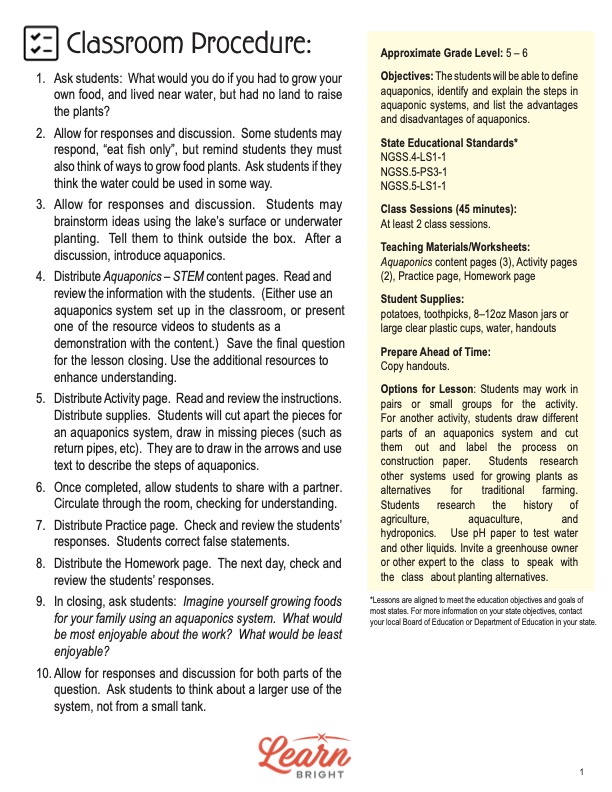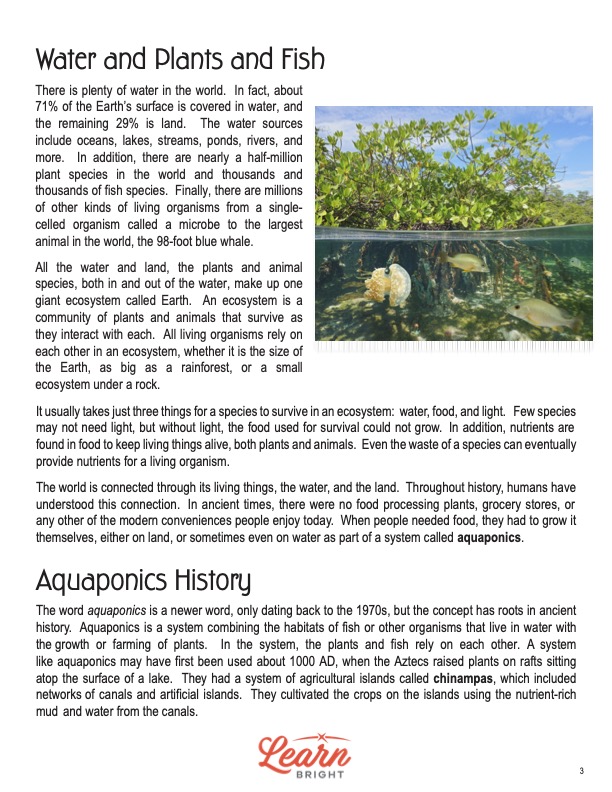Description
What our Aquaponics STEM lesson plan includes
Lesson Objectives and Overview: Aquaponics STEM teaches students about a system that combines water habitats with farming to grow plants. Students will learn that, while the term is fairly new, the practice dates back hundreds of years. They will also discover the advantages and disadvantages of using this system to grow plants. This lesson is for students in 5th grade and 6th grade.
Classroom Procedure
Every lesson plan provides you with a classroom procedure page that outlines a step-by-step guide to follow. You do not have to follow the guide exactly. The guide helps you organize the lesson and details when to hand out worksheets. It also lists information in the yellow box that you might find useful. You will find the lesson objectives, state standards, and number of class sessions the lesson should take to complete in this area. In addition, it describes the supplies you will need as well as what and how you need to prepare beforehand. For this lesson, you will need potatoes, toothpicks, water, and 8–12oz Mason jars or large clear plastic cups in addition to the handouts.
Options for Lesson
This section of the classroom procedure page lists a number of ideas for additional things to incorporate into the lesson. For an additional activity, you could have students draw different parts of the aquaponics system, cut them out, and label the process on a piece of construction paper. Another idea is to have students research other ways that people grow plants as alternatives to traditional farming. Students could also research the history of agriculture, aquaculture, and hydroponics. If you have pH strips, students could test the pH value of water and other liquids. One final idea is to invite a greenhouse owner or other expert to speak with the class about planting alternatives.
Teacher Notes
The paragraph on the teacher notes page offers a little more insight into what you can expect from the lesson plan. It suggests that you should try to get a commercial aquaponics system for the classroom if you can. Use the blank lines on the page to write out ideas you have as you prepare the lesson for your students.
AQUAPONICS STEM LESSON PLAN CONTENT PAGES
Water, Plants, and Fish
The Aquaponics STEM lesson plan contains four content pages. The first page provides students with some background information about water and ecosystems. Water covers about 71% of the earth, which means the rest is land. Water sources vary from oceans to lakes to ponds and streams. Millions and millions of plant and animal species in and out of the water make up one giant ecosystem, which is the earth.
An ecosystem is a community of plants and animals that survive as they interact with each other. All living organisms rely on each other in an ecosystem, whether it is as big as the earth or as small as the area beneath a rock. And there are usually only a few necessities required for a species to survive in an ecosystem.
In general, every ecosystem needs water, food, and light. A few species may not need light specifically, but light is still necessary for the growth of the food those species need. Nutrients in food keep living things, like plants and animals, alive. Even the waste of a species can eventually provide nutrients for other living organisms.
The world is connected through its living things, the water, and the land. Throughout history, humans have understood this connection. In ancient times, people didn’t have food processing plants, grocery stores, or other modern conveniences. When they needed food, they had to grow it themselves, either on land or using a system called aquaponics.
History of Aquaponics
The word aquaponics is fairly new, dating back only to the 1970s. However, the concept is actually very old and dates back to ancient times. Aquaponics is a system that combines the habitats of fish or other water-dwelling organisms with the growth or farming of plants. In this system, plants and fish rely on each other.
Some historians believe the Aztecs first used the system in about 1000 AD. The people raised plants on rafts that sat on top of the surface of a lake. They had a system of agricultural islands called chinampas that included networks of canals and artificial islands. They then cultivated crops on the islands using nutrient-rich mud and water from the canals.
Other areas that used the aquaponics system include South China, Thailand, and Indonesia. The people there used the system for the cultivation and farming of their rice paddy fields. They converted the waste from the fish to help the plants receive the nutrients they needed. Modern aquaponics works in a similar way.
Modern Times
Aquaponics relates to two other types of growing systems: aquaculture and hydroponics. Aquaculture is fish farming. It involves breeding, raising, and harvesting plants and animals that live in water environments like ponds, lakes, rivers, and oceans. Today, people use fish farming to raise salmon, carp, tilapia, and other species of fish.
Hydroponics involves growing plants without soil. The plants in these systems do not receive nutrients as “regular” plants do. Instead, they get their nutrients from the water. For example, algae that grows on the surface of water receives its nutrients from the water rather than from soil. Modern aquaponics, then, combines these two systems into one unified or integrated farming system.
One major part of the system is the nitrogen cycle. The waste from fish, food waste, and other materials from plants or animals in the water produces ammonia. Ammonia itself is toxic to fish and plants, but bacteria (microbes) in the water break down the ammonia and change it into the nitrite. However, nitrite can kill the fish. So then the bacteria break down nitrite into nitrate.
Even though nitrate is also toxic to fish, the plants absorb it into the growbed of the aquaponics system. The process is essentially a self-cleaning water cycle. The fish benefit from clean water while the plants benefit from the nutrients the bacteria generate. The lesson provides a table that lists four steps that explain further how aquaponics works using a tank, pump, and growbed.
Advantages and Disadvantages
Large-scale aquaponics users in particular use this system for farming despite the cons. Because the system is fairly new to some areas of the world, the future holds some promise as scientists conduct more research. However, like most things, there are both pros and cons to using this method to grow or farm various plants.
In the list of advantages, students will discover that this system conserves water. The plants receive nutrients through the water, and there is no toxic run-off. To work effectively, the system only needs about 10% of the amount of water that traditional gardening or farming requires. In addition, it creates a natural ecosystem without chemicals or pesticides, and it generates less pollution.
Plants even grow more quickly and have a higher nutritional value using this method. The system requires less work and can be used almost anywhere that there is water. It needs less space and be set up in places where there is not usually much plant growth.
On the other hand, the number of plants that this system can grow is limited. It may also cost more than traditional farming. Additionally, electricity costs increase because of the pumps, but some people offset these costs by using wind or solar power. Finally, it is possible to overcrowd fish, test water inaccurately, or clear waste insufficiently.
AQUAPONICS STEM LESSON PLAN WORKSHEETS
The Aquaponics STEM lesson plan includes three worksheets: an activity worksheet, a practice worksheet, and a homework assignment. Each of these will assist students in solidifying their grasp of the lesson material and allow them to demonstrate what they learned in different ways. The guidelines on the classroom procedure page outline when to hand out each worksheet to the class.
STEM ACTIVITY WORKSHEET
Because this lesson is STEM, it offers students a hands-on activity during which they will build their own aquaponics system. The supplies students will need are at the top of the worksheet. (You may have students work in pairs or small groups rather than alone if you want to save on supplies.) The worksheet outlines the directions to follow for both a white potato and a sweet potato. You might want to divide the class in half and give one half white potatoes and one half sweet potatoes. Students will need to observe their jars every day for about 18 to 20 days.
MATCH THE DEFINITION PRACTICE WORKSHEET
The practice worksheet includes two parts. For the first part, students will read 15 definitions and match them to the correct term from the word bank on the right. The second section requires them to read six statements and decide whether each one is true (T) or false (F).
AQUAPONICS STEM HOMEWORK ASSIGNMENT
Similar to the practice worksheet, the homework assignment has two parts. The first part requires students to sort the steps of an aquaponic system in order from 1 to 10. The worksheet provides both the first and last steps, so students will only need to sort steps 2 through 9. For the second part, students will review 10 statements. They will then decide if each statement represents an advantage of aquaponics (A) or traditional farming (F).
Worksheet Answer Keys
The final two pages of the lesson plan are answer keys for the practice and homework worksheets. All the correct answers are in red to make it easy for you to compare them with students’ responses. Given the nature of the worksheets, there should be no variation to students’ answers. If you choose to administer the lesson pages to your students via PDF, you will need to save a new file that omits these pages. Otherwise, you can simply print out the applicable pages and keep these as reference for yourself when grading assignments.









